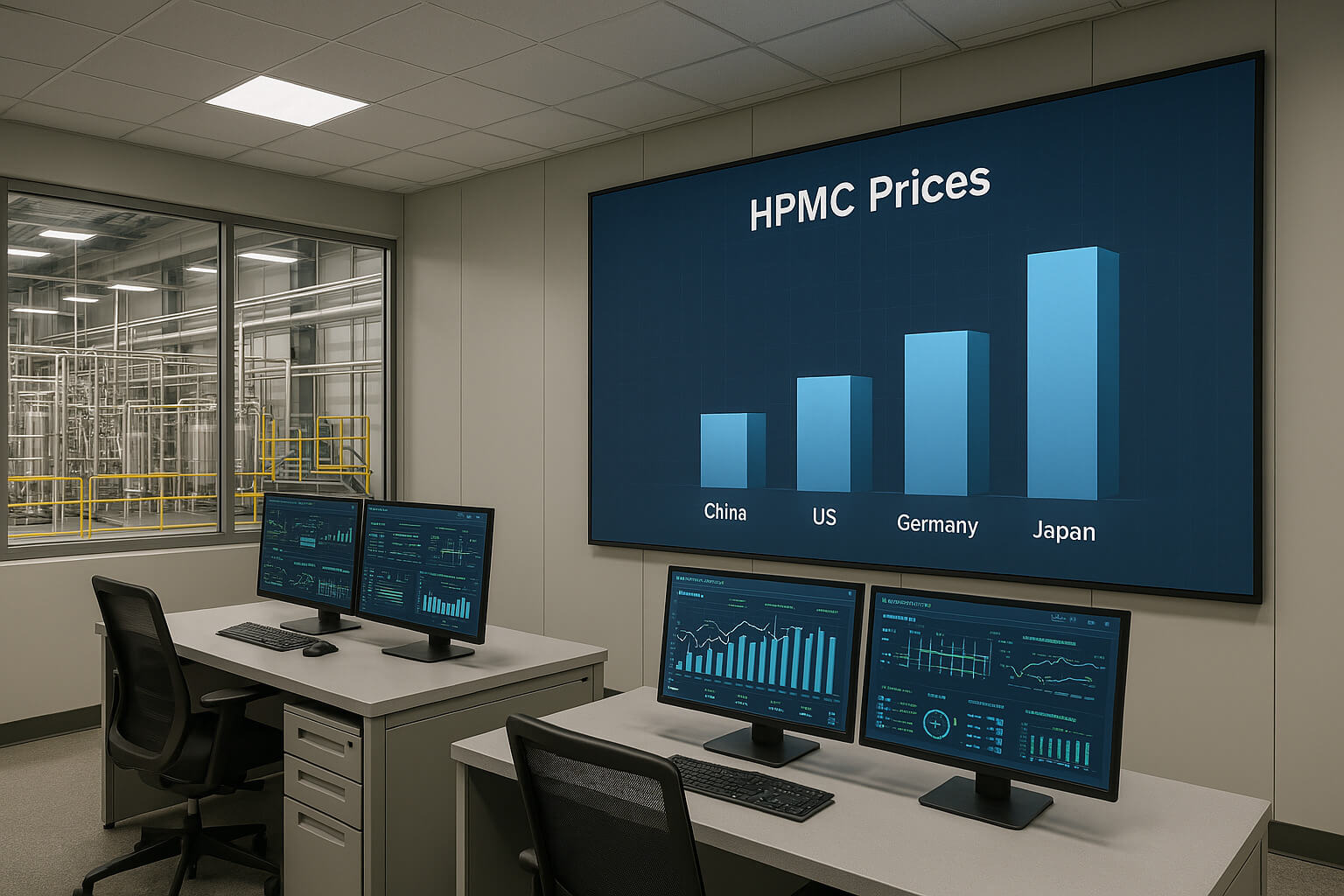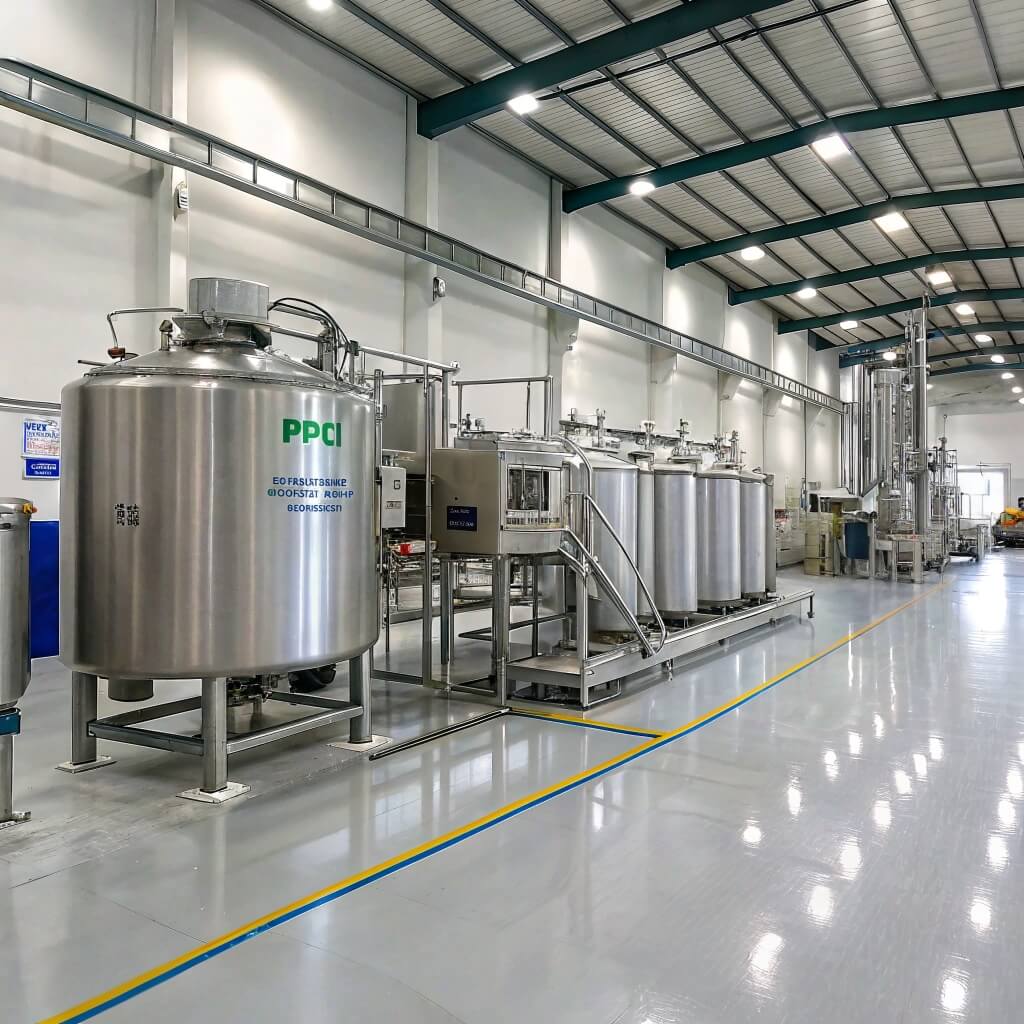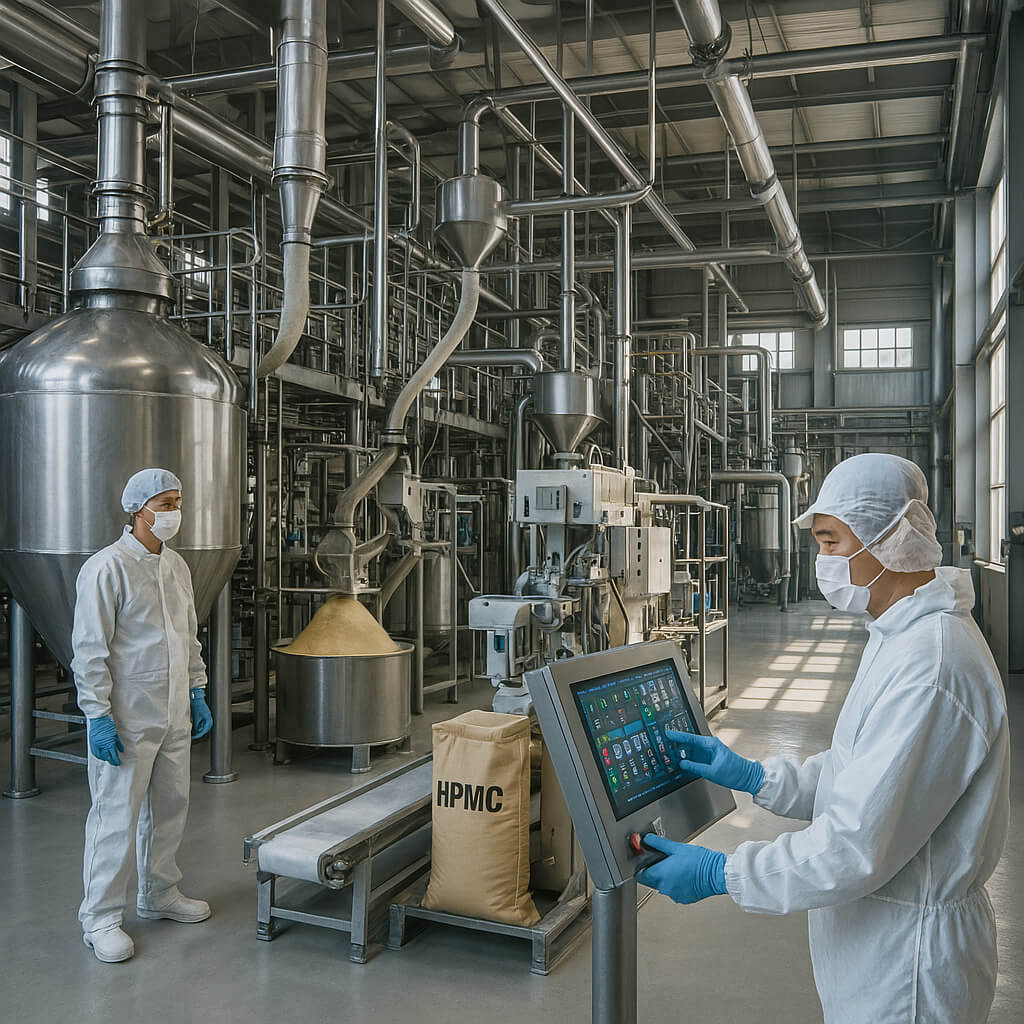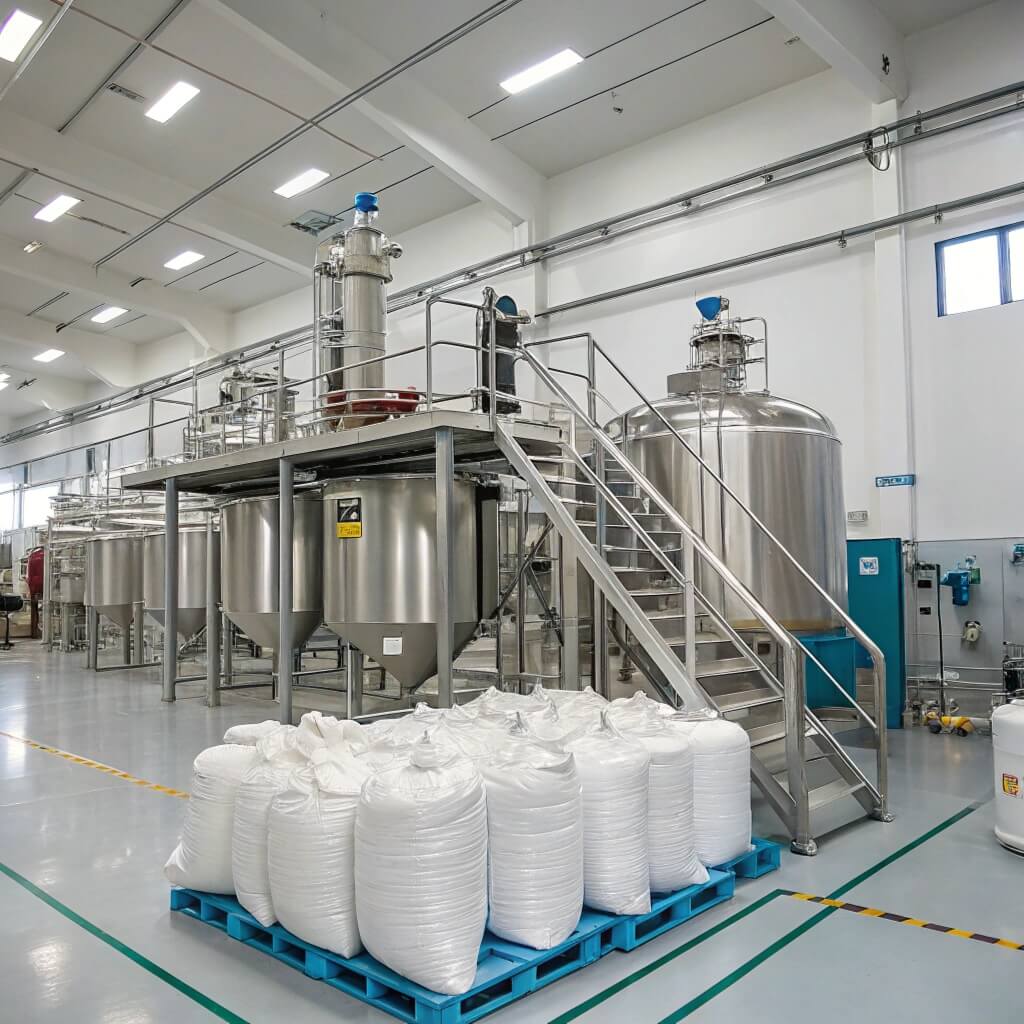Balancing quality and cost in HPMC procurement challenges even experienced buyers. Is Chinese HPMC truly more economical, and if so, at what potential trade-offs?
HPMC from China typically costs 15-30% less than Western or Japanese equivalents, with construction grades priced at $3-5/kg and pharmaceutical grades at $7-15/kg. This pricing advantage stems from lower manufacturing costs, vertical integration, and government support, though quality consistency can vary between suppliers.

A detailed chart comparing HPMC pricing across different global markets, highlighting the cost advantage of Chinese manufacturers compared to Western and Japanese suppliers.
Understanding the factors behind China’s competitive HPMC pricing helps procurement managers make informed decisions that balance cost savings against quality and supply reliability considerations.
What is the current landscape of HPMC pricing in China?
Price variations between suppliers can be substantial. What pricing structure should you expect when sourcing HPMC from China?
Chinese HPMC pricing follows a tiered structure based on application categories. Construction-grade HPMC ranges from $3-5/kg depending on viscosity and modification levels. Food-grade HPMC typically commands $5-8/kg due to additional purity requirements. Pharmaceutical-grade HPMC represents the premium tier at $7-15/kg, with pricing directly correlated to pharmacopeia compliance. The China Chamber of Commerce of Metals, Minerals & Chemicals Importers & Exporters provides industry pricing trend data confirming these ranges.
Viscosity significantly impacts pricing across all categories. Low viscosity grades (5-10,000 mPa·s) represent the lower end of each price range, while high viscosity grades (100,000+ mPa·s) command premium pricing due to more complex manufacturing processes. This viscosity premium typically adds 15-25% to base pricing.
Volume-based pricing tiers create significant cost variation. Small volume orders (at or near MOQ levels of 500-1,000 kg) typically incur base pricing or slight premiums of 5-10%. Mid-volume orders (3-5 tons) often receive discounts of 5-10%. Large volume orders (10+ tons) may secure discounts of 10-15%, while contract manufacturing arrangements with annual volume commitments can achieve discounts of 15-20%.
Manufacturer tier significantly impacts pricing. Tier 1 manufacturers with international certifications and comprehensive quality systems typically command premium pricing of 10-20% above market averages but deliver consistent quality. Tier 2 manufacturers offer mid-range pricing with acceptable quality for less demanding applications. Tier 3 manufacturers may offer significantly lower pricing but present higher quality variation risks.
| HPMC Category | Price Range (USD/kg) | Key Price Determinants | Typical Volume Discounts |
|---|---|---|---|
| Construction Grade | $3-5 | Viscosity, substitution degree, volume | 5-15% for 5+ ton orders |
| Food Grade | $5-8 | Purity level, certification, particle size | 5-12% for 3+ ton orders |
| Pharmaceutical Grade | $7-15 | Pharmacopeia compliance, documentation | 3-10% for 2+ ton orders |
| Specialty Grades | $6-18 | Performance parameters, customization | 3-8% for specialized formulations |
How does the cost of HPMC from China compare to global markets?
Price differentials can determine sourcing strategy. What cost advantages do Chinese HPMC suppliers offer compared to other regions?
Chinese HPMC typically costs 15-30% less than equivalent Western or Japanese products across most application categories. This pricing differential is most pronounced in construction-grade products, where Chinese manufacturers offer pricing of $3-5/kg compared to $4.50-7/kg for Western equivalents and $5-8/kg for Japanese products. The International Trade Centre provides trade data confirming these price differentials across major export markets.
Pharmaceutical-grade HPMC shows a narrower but still significant price advantage. Chinese USP/EP/JP-compliant pharmaceutical grades typically range from $7-15/kg depending on specifications, compared to $9-18/kg for Western equivalents and $10-20/kg for Japanese products. This narrower differential reflects the more stringent quality requirements and regulatory compliance costs that apply regardless of manufacturing location.
The cost advantage varies significantly by manufacturer tier within China. Premium Chinese manufacturers (Tier 1) with international certifications typically price their products 10-15% below Western equivalents, offering a balanced value proposition of cost savings with comparable quality assurance. Mid-tier Chinese manufacturers (Tier 2) typically price 20-25% below Western equivalents but may present greater quality variation.
Total cost of ownership calculations often modify the apparent price advantage. When factoring in potential quality variation, higher inspection requirements, longer lead times, and inventory carrying costs, the effective cost advantage of Chinese HPMC typically narrows to 10-20% for most buyers.
| Region | Construction Grade ($/kg) | Food Grade ($/kg) | Pharmaceutical Grade ($/kg) | Relative Quality Consistency |
|---|---|---|---|---|
| China | $3-5 | $5-8 | $7-15 | Varies by manufacturer tier |
| Western Europe/USA | $4.50-7 | $7-10 | $9-18 | High consistency across manufacturers |
| Japan | $5-8 | $8-12 | $10-20 | Very high consistency |
| India | $3.50-5.50 | $5.50-9 | $8-16 | Moderate consistency |
| Turkey/SE Asia | $3.25-5.25 | $5.25-8.50 | $7.50-16 | Moderate to variable consistency |
What are the main factors that drive HPMC production costs in China?
Understanding cost structures reveals value opportunities. Which economic factors create China’s HPMC pricing advantage?
Several interconnected factors contribute to China’s competitive HPMC production costs, creating structural advantages that enable lower pricing while maintaining acceptable quality levels for most applications.
Labor cost advantages, while diminishing in recent years, still contribute significantly to China’s competitive position. HPMC manufacturing requires substantial labor input for material handling, quality control, packaging, and facility maintenance. Chinese labor costs in chemical manufacturing remain 60-70% lower than Western equivalents. The International Labour Organization provides comparative labor cost data confirming this advantage.
Raw material integration creates another significant cost advantage. Many leading Chinese HPMC manufacturers operate within vertically integrated supply chains with direct access to cellulose raw materials and chemical modifiers. This integration eliminates intermediary margins and reduces transportation costs compared to Western manufacturers who typically source materials through multiple supply chain layers.
Scale economics significantly impact production costs. China hosts the world’s largest concentration of HPMC manufacturing capacity, with many facilities operating at scales that optimize equipment utilization and overhead distribution. Leading manufacturers operate continuous production lines with capacities of 5,000-10,000 tons annually, compared to typical Western batch production at smaller scales.
Regulatory compliance costs represent another significant factor. Western and Japanese manufacturers operate under stringent environmental, safety, and labor regulations that increase both capital and operating costs. While Chinese environmental regulations have strengthened considerably, enforcement remains more variable, and overall regulatory compliance costs typically remain 20-30% lower than Western equivalents.
| Cost Factor | China Advantage | Impact on Final Pricing | Trend Direction |
|---|---|---|---|
| Labor Costs | 40-70% lower than Western/Japanese | 10-15% cost reduction | Gradually narrowing |
| Raw Material Integration | 10-15% lower material costs | 5-8% cost reduction | Stable advantage |
| Scale Economics | 15-20% lower conversion costs | 7-10% cost reduction | Increasing advantage |
| Regulatory Compliance | 20-30% lower compliance costs | 5-8% cost reduction | Rapidly narrowing |
| Capital Costs | 30-40% lower investment requirements | 5-7% cost reduction | Stable advantage |
Why do global buyers prefer sourcing HPMC from Chinese suppliers?
Cost alone rarely drives sourcing decisions. What additional benefits attract international buyers to Chinese HPMC?
While pricing advantages represent a primary driver for sourcing HPMC from China, several additional factors contribute to China’s dominant position in global HPMC supply.
Production capacity and availability stand as significant advantages. China hosts approximately 70% of global HPMC manufacturing capacity, with annual production exceeding 400,000 tons across all grades. This capacity concentration ensures product availability even during demand surges and provides supply security through multiple sourcing options within the same region. The China National Chemical Information Center provides industry capacity data confirming China’s dominant production position.
Manufacturing flexibility represents another key advantage. Chinese manufacturers typically demonstrate greater willingness to produce customized grades with modified specifications compared to Western manufacturers who often focus on standardized product portfolios. This flexibility extends to accommodating smaller minimum order quantities for specialized grades and adapting production schedules to meet urgent requirements.
Quality improvement trajectories have strengthened China’s competitive position. Leading Chinese manufacturers have made substantial investments in quality management systems, analytical capabilities, and process controls over the past decade. While quality consistency still varies between manufacturer tiers, top Chinese producers now achieve quality parameters comparable to Western standards for most applications.
| Advantage Factor | Buyer Benefit | Most Relevant For |
|---|---|---|
| Production Capacity | Supply security, availability during demand surges | High-volume buyers, growing applications |
| Manufacturing Flexibility | Customized grades, lower MOQs for specialties | Product development, specialized applications |
| Quality Improvement | Cost savings without performance compromise | Quality-sensitive but cost-conscious applications |
| Technical Support | Application development assistance, troubleshooting | Buyers with limited internal R&D resources |
How do price differences vary by HPMC grade and application?
Application requirements influence value calculations. How do pricing differentials vary across HPMC product categories?
HPMC pricing differentials between Chinese and Western/Japanese suppliers vary significantly across different grades and applications, creating a nuanced value proposition that procurement managers must evaluate based on specific requirements.
Construction-grade HPMC shows the most substantial pricing differential, with Chinese products typically 25-35% less expensive than Western equivalents and 30-40% below Japanese alternatives. This category includes general-purpose grades for tile adhesives, renders, mortars, and gypsum applications. The Construction Chemicals Manufacturers Association provides comparative pricing data confirming these differentials.
Within the construction segment, commodity grades for basic applications show the largest price advantages at 30-35% below Western alternatives. Performance-optimized construction grades with enhanced water retention, workability, or adhesion properties show somewhat narrower differentials of 20-25%, reflecting the greater technical requirements and quality consistency needs.
Food-grade HPMC presents a more moderate pricing differential, with Chinese products typically 20-25% below Western equivalents and 25-30% below Japanese alternatives. This category requires higher purity levels, stricter quality controls, and food safety certifications that narrow the manufacturing cost gap between regions.
Pharmaceutical-grade HPMC shows the narrowest pricing differential, with Chinese USP/EP/JP-compliant grades typically 15-20% below Western equivalents and 20-25% below Japanese alternatives. This category faces the most stringent quality, consistency, and documentation requirements, substantially narrowing the manufacturing cost gap between regions.
| HPMC Category | Chinese Price ($/kg) | Western Price ($/kg) | Price Differential | Quality Consideration |
|---|---|---|---|---|
| Basic Construction | $3.00-4.00 | $4.50-6.00 | 30-35% lower | Acceptable for standard applications |
| Performance Construction | $3.50-5.00 | $5.00-7.00 | 20-25% lower | Gap narrowing for leading Chinese producers |
| Food Grade | $5.00-8.00 | $7.00-10.00 | 20-25% lower | Requires careful supplier qualification |
| Basic Pharmaceutical | $7.00-12.00 | $9.00-15.00 | 15-20% lower | Top-tier Chinese suppliers comparable to Western |
| Specialized Pharmaceutical | $10.00-15.00 | $12.00-18.00 | 10-15% lower | Narrowest gap for critical applications |
What are the future trends in HPMC China pricing and global market outlook?
Strategic procurement requires forward-looking analysis. How will Chinese HPMC pricing evolve in coming years?
Several interconnected factors are reshaping the HPMC pricing landscape in China and globally, creating both challenges and opportunities for procurement strategies in the coming years.
Raw material cost pressures represent a significant factor driving HPMC pricing trends. Cellulose pulp, the primary raw material for HPMC production, has experienced price volatility with an upward trend due to competing demand from paper, textile, and other cellulose derivative applications. Chinese manufacturers face 5-10% annual increases in raw material costs, gradually eroding some of their pricing advantage. The Pulp and Paper Products Council provides market data showing these sustained raw material cost pressures.
Environmental compliance costs are rapidly increasing for Chinese manufacturers. China’s strengthened environmental regulations and enforcement actions have required substantial investments in emissions control, wastewater treatment, and hazardous material management. These investments typically increase manufacturing costs by 5-8% for compliant producers, with further increases anticipated as standards continue to tighten.
Labor cost trajectories continue to impact comparative economics. Chinese manufacturing wages have increased at 5-8% annually over the past decade, significantly outpacing Western wage growth of 2-3%. This differential growth rate is gradually eroding China’s labor cost advantage, particularly for higher-skilled positions in quality control, process engineering, and technical management.
| Trend Factor | Impact on Chinese HPMC Pricing | 5-Year Outlook |
|---|---|---|
| Raw Material Costs | 5-10% annual increases | Continued upward pressure, especially for cellulose |
| Environmental Compliance | 5-8% cost increase for compliant producers | Accelerating impact as standards tighten |
| Labor Costs | 5-8% annual increases | Gradually eroding but not eliminating labor cost advantage |
| Quality Investments | 3-5% operating cost increase | Continuing trend, especially for higher-value grades |
FAQs
What is the price of HPMC in China?
HPMC pricing in China follows a tiered structure based on application category, specifications, and volume. Construction-grade HPMC typically ranges from $3-5/kg, with pricing directly correlated to viscosity and substitution degree. Food-grade HPMC generally ranges from $5-8/kg, reflecting higher purity requirements. Pharmaceutical-grade HPMC represents the premium tier at $7-15/kg, with pricing determined by pharmacopeia compliance and specific performance parameters. Volume significantly impacts pricing, with discounts of 5-15% available for larger orders and potential premiums for minimum quantity orders. Manufacturer tier also influences pricing, with top-tier producers commanding 10-20% premiums over market averages but delivering greater quality consistency and technical support.
Who is the largest producer of HPMC?
The global HPMC market features several major producers across different regions. In China, the largest producers include Shandong Head, Anhui Sunhere, Hopetop Pharmaceutical, and Morton, each with annual production capacities exceeding 20,000 tons. Globally, Dow Chemical (USA), Shin-Etsu (Japan), and Ashland (USA) represent major Western and Japanese producers, though their individual HPMC capacities are generally smaller than the leading Chinese manufacturers. China now hosts approximately 70% of global HPMC manufacturing capacity, making it the dominant production region. When selecting suppliers, buyers should consider not only production capacity but also quality consistency, technical support capabilities, and application-specific expertise.
How much does HPMC cost?
HPMC pricing varies significantly based on grade, specifications, origin, and volume. Chinese construction-grade HPMC typically ranges from $3-5/kg, compared to $4.50-7/kg for Western equivalents and $5-8/kg for Japanese products. Food-grade HPMC from China generally costs $5-8/kg, while pharmaceutical grades range from $7-15/kg depending on pharmacopeia compliance and performance specifications. Viscosity significantly impacts pricing, with high viscosity grades commanding premiums of 15-25% over low viscosity alternatives due to manufacturing complexity. Order volume creates substantial price variation, with volume discounts of 5-15% for larger orders.
Is HPMC expensive?
HPMC pricing should be evaluated in the context of its functional value rather than absolute cost. While HPMC represents a significant raw material expense in many formulations, its functional contribution often justifies the investment through performance benefits and formulation efficiency. In construction applications, HPMC typically constitutes 0.2-0.5% of dry mix formulations but delivers critical performance properties including water retention, workability, adhesion, and sag resistance that significantly impact end-product quality. The cost impact typically ranges from $0.01-0.03 per kg of finished construction material, representing 1-3% of total formulation cost. In pharmaceutical applications, HPMC may represent a higher percentage of formulation cost but enables controlled release properties and manufacturing efficiencies.
Conclusion
The pricing advantage of Chinese HPMC represents a complex value proposition that extends beyond simple cost comparisons. While Chinese products typically cost 15-30% less than Western or Japanese equivalents, the actual value calculation must consider quality consistency, technical support, supply reliability, and application-specific requirements.
For most applications, Chinese HPMC offers compelling value, particularly from top-tier manufacturers who have invested in quality systems and technical capabilities. Construction applications generally present the strongest economic case for Chinese sourcing, while pharmaceutical and food applications require more careful supplier qualification to ensure that cost savings don’t compromise critical performance parameters.
Looking forward, several factors are gradually narrowing China’s pricing advantage, including rising labor costs, strengthened environmental regulations, and quality system investments. However, manufacturing scale, technology upgrades, and vertical integration continue to sustain meaningful cost advantages that will likely persist for the foreseeable future.
Contact Morton today to discuss your specific HPMC requirements and how our optimized production processes deliver exceptional value across construction, pharmaceutical, and food applications. Our technical team can provide detailed cost-performance analysis for your specific formulations, helping you balance economic and performance considerations.




